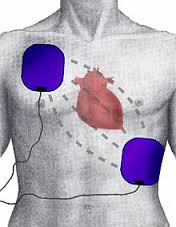Defibrillation pads are placed on the patients bare chest. All defibrillators sold by your Defibshop have clear instructions on where to place the defibrillation pads. Simply, they go on the front (anterior) of the chest, one above the right nipple, and the other on the left side of the chest below the left breast area. The only exception is for paediatrics, where one is placed on the back chest wall (posterior) and the other on the front (anterior) left chest wall. The general principle of defibrillation is to deliver a shock through the heart, from one side to the other, resulting in the heart being shocked back into a regular rhythm.
See the picture below to show approximate location of the defibrillation pads for an adult using a standard public access defibrillator:

What about:
Large breasts:
Patients with large breasts (can be female or male) need to have the left defibrillator pad placed where possible under the breast tissue. Simply elevate the breast tissue with one hand, whilst placing the defibrillation pad on the chest with the other hand.
Jewellery:
Jewellery, such as nipple piercings and necklaces should be removed and defibrillation pads should not come in contact with any metal jewellery.
Tattoos:
There are no problems with defibrillation and tattoos. Defibrillation pads can be placed over the top of tattoos without affecting the shock being delivered.
Pacemakers:
Some patients will have a pacemaker already fitted due to previous cardiac conditions. There are no problems defibrillating a patient who already has a pacemaker. All defibrillators will defibrillate a patient with or without a pacemaker.
Scars:
Generally, all scar tissue from any previous cardiac or other surgery will not be in the area of where defibrillation pads will be placed. However, scar tissue is not of a concern anyway and defibrillation pads can be placed over scar tissue, and shocks will be delivered successfully.
If you have any questions, call your Defibshop on 1300 729 575

